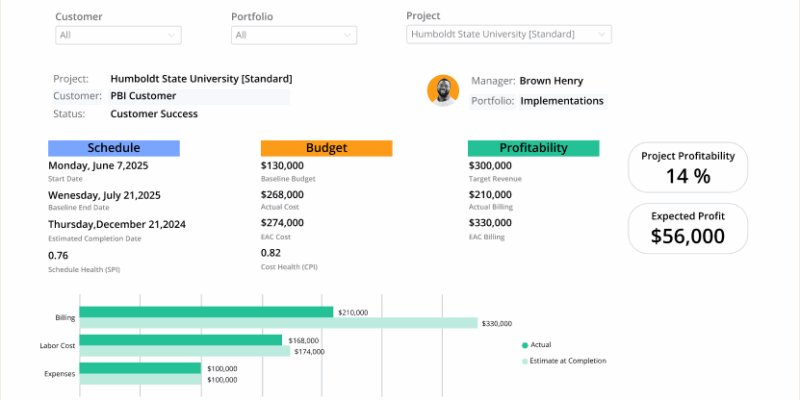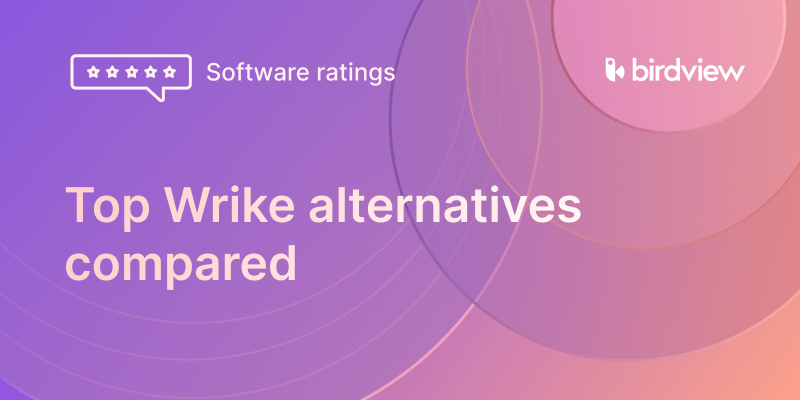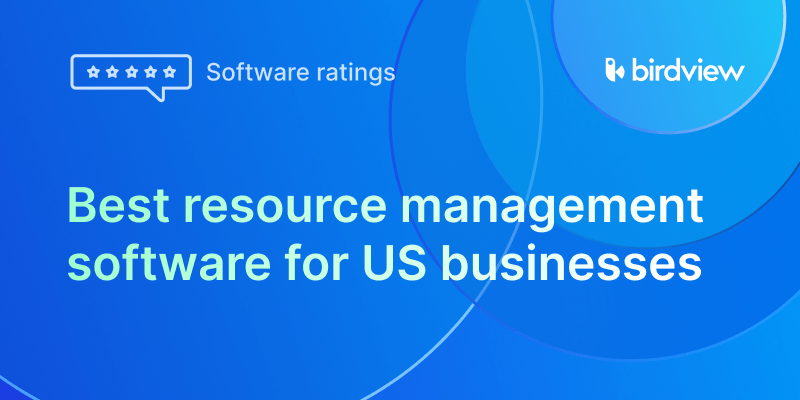As a resource manager, your role is pivotal. You’re the architect of team capacity, the air traffic controller for project assignments, and the guardian against overwork and underutilization. You know that getting the right people on the right tasks at the right time isn‘t just logistics–it‘s what keeps projects on time, quality high, and your team from burning out.
But in fast-moving professional services environments, nothing stays still for long. Timelines shift. Priorities change. People take unexpected time off. How do you keep everyone‘s workload balanced and your team operating at full capacity? Spreadsheets and email threads won‘t cut it anymore.
You need a clear strategy–and a tool that gives you real-time visibility, flexibility, and control. That‘s where PSA software, and specifically Birdview PSA, becomes your daily command center for resource allocation.
In this article, we‘ll explore the daily realities resource managers face, share proven strategies for staying on top of resource planning, and show how Birdview PSA helps turn those strategies into results–preventing burnout, keeping projects on track, and making your job easier.
In this article
The daily grind: resource allocation challenges for resource managers
Being a Resource Manager means constantly wrestling with challenges that impact team workload and project progress:
- Balancing Competing Demands: Multiple project managers requesting the same key resources simultaneously.
- Identifying Real-Time Availability: Knowing who is truly available, considering project assignments, time off, and potential unplanned absences.
- Preventing Over/Under-utilization: Ensuring workloads are distributed evenly to avoid burnout for some and wasted capacity for others.
- Matching Skills to Tasks: Identifying resources with the right expertise for specific project needs.
- Responding to Change: Rapidly adjusting resource allocation when project timelines shift or new priorities emerge.
- Managing Time Off: Tracking vacations, holidays, and sick days and their impact on team capacity.
- Communicating Allocation Decisions: Clearly communicating assignments and workload expectations to project managers and team members.
- Forecasting Future Needs: Predicting future resource requirements based on the project pipeline and upcoming opportunities.
These are the challenges you face every day, requiring not just intuition, but clear processes and reliable data.
Your daily playbook: strategies for effective resource allocation
Effective resource allocation isn’t about grand gestures; it’s about consistent, smart daily actions. Here are key strategies for your Resource Manager’s playbook, powered by Birdview PSA:
1. Start with a daily resource check-in
- Strategy: Begin your day by reviewing your team’s overall resource availability and workload for the immediate period (today/this week). Identify any unexpected absences or sudden shifts in availability that might impact assignments.
- Birdview PSA Action: Use the Resource Workload view in Birdview PSA to see a clear overview of your team’s daily schedule, including time off and planned assignments. Check for any alerts indicating overbookings or conflicts.
2. Review incoming resource requests
- Strategy: Process new resource requests from project managers promptly. Assess the resource requirements, urgency, and priority of each request.
- Birdview PSA Action: Utilize the resource request functionality in Birdview PSA to receive and review incoming requests in a centralized location. Prioritize requests based on project importance and resource needs.
3. Match skills and roles to assignments
- Strategy: When evaluating resource requests or open tasks, actively match the required Job Roles and Skills to available team members. Don’t just assign based on availability; ensure the best fit based on expertise.
- Birdview PSA Action: Use Birdview PSA’s resource search and filtering capabilities to find resources based on required Job Roles and Skills. Leverage the AI-powered resource suggestions to identify best-fit candidates.💡 Useful Tip: Maintain up-to-date Skills and Job Role profiles for your team members in Birdview PSA for more accurate matching.
4. Proactively manage workload balancing
- Strategy: Regularly review your team’s workload to identify potential over- or under-utilization before it becomes a problem. Reallocate tasks or adjust assignments to ensure a balanced workload management across the team.
- Birdview PSA Action: Use the Workload Tab or Resource Loading Reports in Birdview PSA to visualize team workload. Identify resources operating above or below capacity and use drag-and-drop functionality to reassign tasks.💡 Useful Tip: Schedule a recurring task for yourself in Birdview PSA to review resource workloads weekly and make necessary adjustments.
5. Communicate Allocation Decisions Clearly
- Strategy: Ensure project managers and team members are clearly informed of allocation decisions and assignment changes. Provide context and expectations.
- Birdview PSA Action: Use Birdview PSA’s internal messaging or task comments to communicate allocation decisions directly within the platform. Project managers are automatically notified when resources are assigned to their projects.
6. Monitor project progress and its impact on resources
- Strategy: Keep an eye on how projects are progressing. If a project is delayed, it might free up resources sooner or delay the need for resources planned for a later stage. Adjust resource allocation accordingly.
- Birdview PSA Action: Use Birdview PSA’s project tracking features and dashboards to monitor project progress. If a project status changes, assess its impact on the planned resource allocation and make adjustments in your resource planning module

7. Plan time off strategically
- Strategy: Actively manage and plan for team members’ time off to understand its impact on overall capacity and resource allocation for upcoming periods.
- Birdview PSA Action: Use Birdview PSA’s time-off management features to track planned vacations and holidays. This data is automatically factored into resource availability views and reports.
8. Use data to inform conversations and decisions
- Strategy: Leverage the data from Birdview PSA‘s Resource Loading Reports and utilization reports to inform discussions with project managers about resource needs, workload capacity, and planning. Use data to justify hiring requests or resource adjustments.
- Birdview PSA Action: Share reports and dashboards from Birdview PSA that clearly illustrate resource utilization, workload, and capacity with relevant stakeholders.
9. Continuously refine your process
- Strategy: Your resource allocation process isn’t static. Regularly review what’s working and what’s not. Gather feedback from project managers and team members on the effectiveness of resource assignments and workload balance.
- Birdview PSA Action: Use the data in Birdview PSA to analyze historical resource allocation patterns and their impact on project outcomes. Identify areas for improvement in your daily strategies and refine your process.
By applying these daily strategies with support from Birdview PSA, you turn resource allocation from a reactive chore into a proactive, strategic routine. With real-time visibility and smart tools at your fingertips, you can balance workloads, reduce risk, and keep your projects and teams on track–every single day.
Birdview PSA: your partner in mastering resource allocation
Birdview PSA isn’t just another tool–it‘s a complete platform built to help resource managers navigate the daily complexity of resource allocation. With real-time visibility, intelligent features, and built-in automation, it empowers you to apply effective strategies with confidence.
You get full transparency into your team‘s skills, job roles, availability, and current workload–all in one place. Birdview PSA helps you stay ahead of conflicts and capacity issues, enabling data-driven decisions around staffing, assignments, and hiring. Routine tasks like tracking availability or making assignments become faster and easier, improving how your team collaborates and communicates.
Most importantly, Birdview PSA helps you maintain balanced workloads. By distributing tasks fairly and adjusting plans in real time, you can avoid burnout, boost productivity, and support your team‘s long-term performance.
In a world where resource allocation directly impacts project delivery, team satisfaction, and profitability, Birdview PSA gives you the tools to lead with clarity and control–every single day.
Professional Services Automation (PSA) software, like Birdview PSA, provides the essential tools and visibility to implement a winning Resource Manager’s playbook. By centralizing data, automating calculations, and offering real-time insights, Birdview PSA empowers you to master resource allocation, prevent burnout, and keep your projects on track.
Equip yourself with the tools to navigate resource challenges confidently. Become the master of resource allocation in your organization.
Discover how Birdview PSA can transform your resource management practice.
or
📚 You may also like:
Frequently Asked Questions
1. What are the biggest challenges for a resource manager?
The biggest challenges for a resource manager include balancing competing project demands, identifying real-time resource availability, preventing over/under-utilization, matching skills to tasks, responding quickly to changes, managing time off, communicating allocation decisions, and forecasting future needs.
2. How can PSA software help a resource manager daily?
PSA software helps a resource manager daily by providing centralized resource visibility, intelligent planning tools, automated alerts for conflicts, workload balancing features, and data for decision-making, streamlining tasks like checking availability, reviewing requests, assigning resources, and monitoring workloads.
3. What are resource loading reports used for?
Resource loading reports are used to visualize and analyze the amount of work assigned to resources over time. They help identify who is overloaded or underutilized, assess capacity versus demand, and inform decisions about balancing workloads and adjusting assignments.
4. How does Birdview PSA help with workload balancing?
Birdview PSA helps with workload balancing by providing visual reports that highlight over/under-utilized resources. It allows resource managers to easily reallocate tasks or adjust schedules based on real-time data to distribute work evenly across the team.
5. Can Birdview PSA track team members’ skills and availability?
Yes, Birdview PSA allows resource managers to define and track team members’ skills and roles, assign proficiency levels, and view real-time availability, including planned time off and current project assignments.
6. How does PSA software prevent resource conflicts?
PSA software prevents resource conflicts by providing real-time visibility into resource availability and assignments, highlighting potential conflicts during resource scheduling, and offering tools to resolve clashes before they impact projects.
7. What is the difference between a resource manager and a project manager?
A resource manager primarily focuses on the overall resource capacity of the organization, allocating resources across multiple projects. A project manager focuses on managing a specific project, ensuring tasks are completed on time and within budget, and managing the resources assigned to that project.
8. How can resource managers use data from Birdview PSA?
Resource managers can use data from Birdview PSA reports and dashboards to analyze resource utilization, justify hiring needs, forecast future resource requirements, identify training opportunities, and inform strategic decisions about resource allocation and planning.
8. Does Birdview PSA support planning for time off and its impact on resources?
Yes, Birdview PSA supports planning for time off by allowing resource managers to track planned vacations and holidays. This time off is factored into resource availability views and reports, providing a more accurate picture of future capacity.
9. How often should a resource manager review resource loading reports?
A resource manager should review resource loading reports regularly, at least weekly or bi-weekly, and especially when planning new projects or during peak periods, to identify potential workload imbalances and conflicts early.



